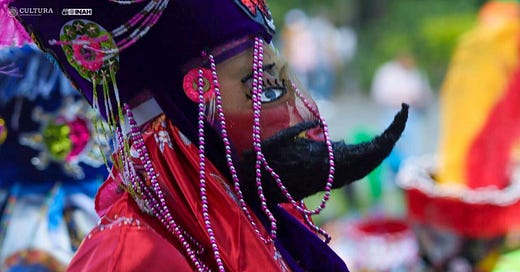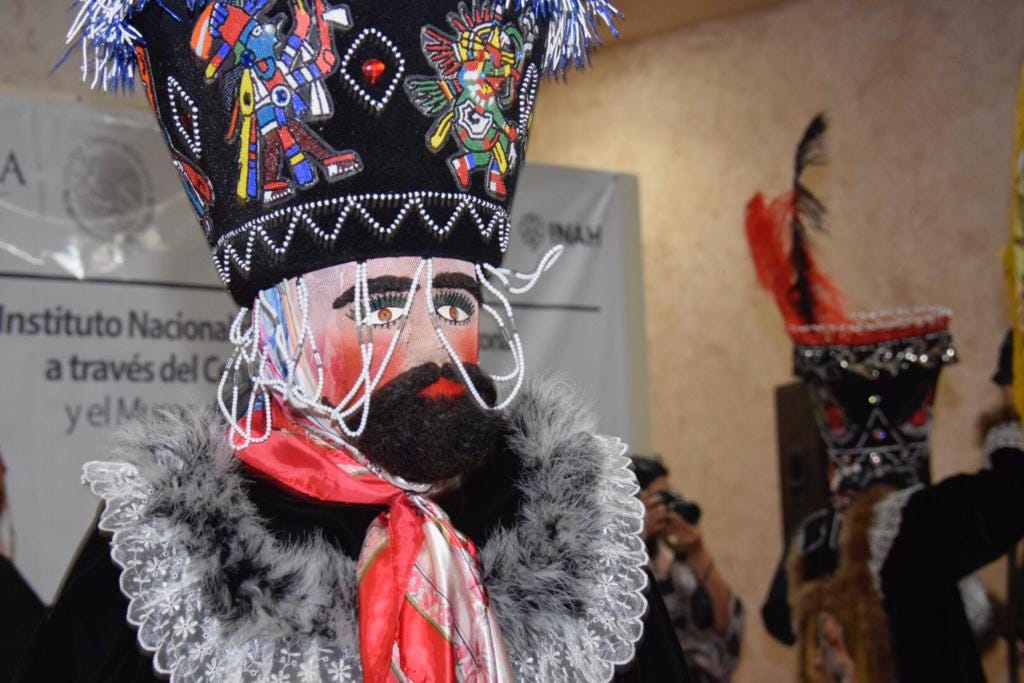A familiar sight at the carnivals that take place around the state of Morelos are the Chinelos. The first time you see them you are surprised. They have exaggerated faces with large noses, pointy chins, huge hats and gloves. They wear elaborate bright long robes, covered with embroidery, beads and sequins. They are strange and always dancing.
Well known amongst the locals here there is an interesting but hardly surprising tale to do with their origin. The Chinelo wears an outfit that is a parody of what the conquistadores, landowners and hacienda owners used to wear back in the 19th century. When they celebrated annual events the workers also wanted to celebrate but were forbidden. So they invented these outfits, with a face mask to hide their identity, and danced in celebration of specific occasions (harvest festival, day of the dead, etc.). They went along the streets of their villages dancing to the sound of pipes and pots which created tunes that were similar to those of the Spanish. Their outfits were a form of resistance, their masks a caricature of the hated landowners, their aim to outwit the people who treated them so badly.
Mexico achieved independence from the Spanish in 1810 but the sugar cane hacienda owners kept control of the land in Morelos, as in other states. The Chinelos first appeared in the 1860s, and performed at the carnivals that were organised from the 1870s onwards. Their persistence and visibility was an initial form of resistance that sowed the seeds of the Mexican Revolution which came 50 years later. It is no coincidence that Emiliano Zapata came from Morelos.
Mexico has a strong tradition of making masks for use in traditional dances and ceremonies which dates back to well before the arrival of the Spanish. Most of them are made of wood, as well as leather, wax, cardboard, papier-mâché and other materials. It is common to find masks that depict Europeans, animals, the supernatural, old men and women, amongst other things.
Over the years the pipes and pots were relinquished in favour of wind instruments and drums. Today bands accompany the Chinelos wherever they dance, the tunes always the same ones. The masks feature up-tilted beards and white skin, topped with very high dome shaped hats which are decorated in many different ways. The symbolism, handcrafted details and level of creativity turn them into astonishing works of art.
The village of Tlayacapan in Morelos is considered to be the place where the Chinelos were first seen. Each village has its own style of hat and robes, a form of identification. Most of the robes are made of velvet, some have lace details, others have trinkets and chains, but sequins, beads and feathers are always featured. They are heavy outfits and the dancers sweat profusely under their weight. The Chinelos make or buy their outfits, it is an important investment. There are mini Chinelos too, young children who dress up like their parents, learning the habit early to maintain the tradition.
Not only do they dance in the local carnivals and on Día de la Independencia but also participate in weddings or private parties. For a price. They come all dressed up, the band plays, and everyone dances. It’s a simple jump (“brincar” in Spanish) or dance: 1, 2, then jump or hop to the right, or to the left. And that’s it. I have hopped/danced my way round the square in the local town with the best of them. This jumping is also a mockery of how the conquistadores used to dance.
The name “Chinelo” comes from the Nahuatl word "zineloquie" which means “disguised." The Chinelos are one of the most important attractions in Morelos and beloved by all.
__
Credits for the photos used here:
https://www.inah.gob.mx/foto-del-dia/chinelos-una-danza-tipica-de-morelos-en-el-inahfest
http://inahchihuahua.gob.mx/sala-de-prensa.pl?id=281







Can you believe I never knew this! Fascinating history. Thank you.